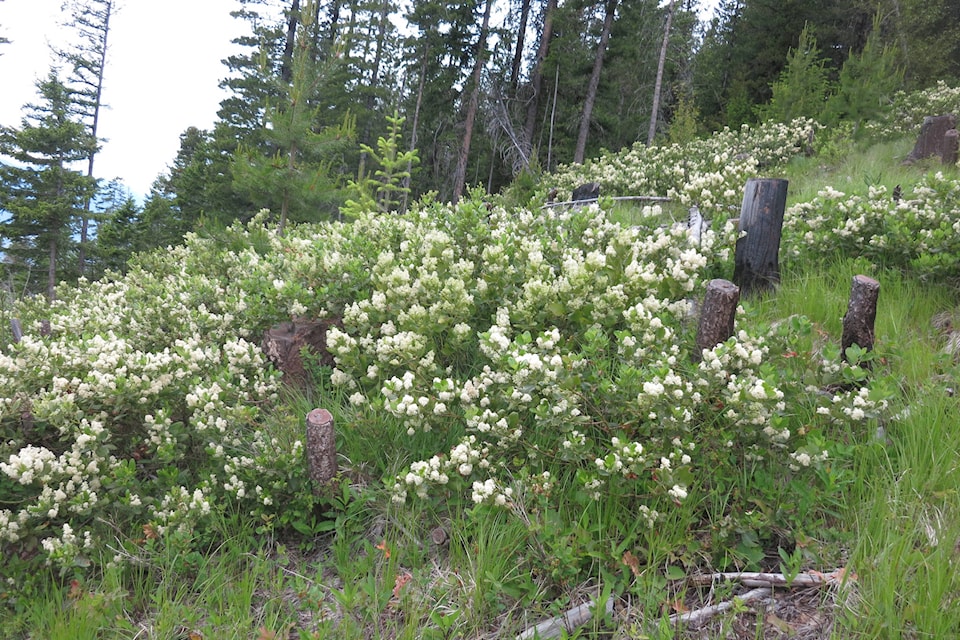By Ed McMackin, a biologist by training and a naturalist by nature
Officially, summer season is here as of June 21 or something like that. But actually, after most springs of being in the area, summer feels and looks like it starts much earlier. Many plants, including shrubs, have already leafed out and some are blooming by May 21. There are a few that bloom earlier in spring, but their flowers are not as noticeable as the following flowering species.
The first shrub that we take notice of is Saskatoon, also called Serviceberry. Its branches are laden with many medium-sized, white flowers, making it a very noticeable shrub along roads and around clearings in the Kootenay Lake-Creston area. Around this tine you may spot Mallow Nine-bark, with its large clusters of small white flowers. The next showy shrub was Buckbrush, which was followed by Snowbrush and the favorite, native Mock Orange, also known as Syringia. Its flowers are significantly perfumed, but the aroma is stronger after it gets dispersed in the air. Before Mock Orange is finished, large clusters of tiny buds, will be seen hanging from Ocean Spray shrubs. Its little buds will turn into many creamy-white flowers.
At the end of June, Mock Orange and Ocean Spray flowers decorate the highway, along Kootenay Lake, from Creston to Meadow Creek. Some, that are done flowering in valley bottoms, grow at higher elevations and may be found up there in flower. For example, if you missed Saskatoon flowers then go a ways up on Mt. Thompson or up to Kootenay Pass.
Now, let’s get back to Buckbrush and Snowbrush. My first acquaintance with Buckbrush, a large shrub, was when learning about the property and what members of the plant kingdom I would be keeping company with. I found that I would end up getting acquainted with about a hundred species of trees, ferns, shrubs and wildflowers. Those I became quite familiar with. However, other members of the plant kingdom, like mosses, lichens, grasses, rushes, sedges and algae, are still a bit of an unknown territory for me.
I didn’t hear of Buckbrush until I arrived in the Kootenay Lake-Creston area. This past spring, I found it to be much more prolific than what I previously thought. Recently, in passing up and down, along the East Shore of Kootenay Lake, many white bunches of little flowers bloomed from the branch-tips of Buckbrush. White flowers of Mallow Ninebark, Ocean Spray, Saskatoon (aka Serviceberry) and Mock Orange, in the following weeks, contrasted sharply with the greenery along the highway.
Buckbrush flowers, to me, smell mildly sweet but with a bit of a “dusty” quality. (I will let you determine what is meant by that.) Many flowers don’t seem to have much sweet aroma when you put your nose right up to them. However, many flower aromas don’t become fragrant until they are wafted on the evening air, at the right temperature and even right humidity.
Another name for Buckbrush is “Red-stemmed Ceanothus”, after the red stems of the new growth. The name Buckbrush may come from the habit of ungulates (deer, elk, and moose) who feed through the winter on the past summer’s tender, new growth. Like willows, Buckbrush shrubs, in some areas, often appear quite “groomed” or pruned, after foraging ungulates have browsed on the new growth.
Buckbush and Snowbursh are similar names; their scientific names are also similar- Ceanothus sanguineus and Ceanothus velutinus. I am not sure why the latter is called, “Snowbrush”. However, it may be called that because the flexible branches, laden with evergreen leaves, bend down to the ground, under the weight of winter snow, and spring back up after the snow melts in the spring season. The main growth of Buckbrush is more vertical while Snowbrush stem growth is on more of an angle. Snowbrush is evergreen, keeping its leathery leaves all year around, while Buckbrush, like many shrubs, has soft leaves, loosing them in the fall and getting a new set in the spring.
My first recollection of Snowbrush is along straight, flat sections of Highway 3 between Yahk and Cranbrook. Then I saw it on the East Castlegar flats and then up on the south aspect of the Loon Lake bluffs. Just a few days ago, for the first time, we spotted large patches of it on open slopes above and below the Mt. Thompson Forest Service Road just up from km. 5.3, the top end of the Pack Trail. It is evident that if a person hasn’t seen something doesn’t mean it isn’t there. My list of known shrubs continues to grow.
Probably, one of the highlights of finding Snowbrush, is discovering that when the leathery leaves are crushed, they give off a kind-of, mildly-spicy, sweet aroma. When you check it out you may or may not find the aroma pleasant and you may describe it differently.
If you are wanting to find out more about plant life in the Kootenay lake-Creston area I suggest referring to the book “Plants of the Southern Interior British Columbia and the Inland Northwest” by Parish, Coupe and Lloyd. You may also type in “Ed McMackin” on Eflora BC and see photos and notes of plants of the Kootenay Lake-Creston area. You may contact me at 1-250-866-5747 or anagallis77th@gmail.com.
READ MORE: Out There: Kootenay Lake and the Land
READ MORE: Out There: A Flower Deception
